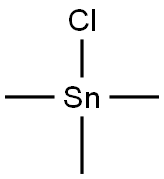
Триметилолово хлорид
- английское имяTRIMETHYLTIN CHLORIDE
- CAS №1066-45-1
- CBNumberCB3277094
- ФормулаC3H9ClSn
- мольный вес199.27
- EINECS213-917-8
- номер MDLMFCD00000520
- файл Mol1066-45-1.mol
| Температура плавления | 37-39 °C (lit.) |
| Температура кипения | 148 °C |
| плотность | 0.988 g/mL at 25 °C |
| Fp | 207 °F |
| температура хранения | Poison room |
| растворимость | Chloroform (Slightly) |
| форма | Liquid |
| Удельный вес | 1.356 |
| цвет | White |
| Запах | Strong unpleasant stench; no threshold data available |
| Растворимость в воде | Soluble in water, chloroform and organic solvents. |
| Чувствительный | Moisture Sensitive |
| Гидролитическая чувствительность | 4: no reaction with water under neutral conditions |
| БРН | 3535111 |
| Пределы воздействия | ACGIH: TWA 0.1 mg/m3; STEL 0.2 mg/m3 (Skin) NIOSH: IDLH 25 mg/m3; TWA 0.1 mg/m3 |
| Стабильность | Moisture Sensitive |
| ИнЧИКей | KWTSZCJMWHGPOS-UHFFFAOYSA-M |
| Справочник по базе данных CAS | 1066-45-1(CAS DataBase Reference) |
| Рейтинг продуктов питания EWG | 1 |
| FDA UNII | 9E3BCA3684 |
| Система регистрации веществ EPA | Trimethyltin chloride (1066-45-1) |
| UNSPSC Code | 12352103 |
| NACRES | NA.22 |
| Коды опасности | T+,N,F | |||||||||
| Заявления о рисках | 26/27/28-50/53-51/53-36/37-19-11-34-40-65-62-48/23/25-36/37/38 | |||||||||
| Заявления о безопасности | 28-36/37-45-61-27-26-16-60-62 | |||||||||
| РИДАДР | UN 3146 6.1/PG 2 | |||||||||
| WGK Германия | 3 | |||||||||
| RTECS | WH6850000 | |||||||||
| F | 10-21 | |||||||||
| TSCA | Yes | |||||||||
| Класс опасности | 6.1 | |||||||||
| Группа упаковки | II | |||||||||
| кода HS | 29319090 | |||||||||
| Банк данных об опасных веществах | 1066-45-1(Hazardous Substances Data) | |||||||||
| Токсичность | LD50 oral (rat) 12.6 mg/kg PEL (OSHA) 0.1 mg tin/m3 The ACGIH has established the following uniform exposure limits for all organotin compounds based on the concentration of tin in air: TLV-TWA (ACGIH) 0.1 mg tin/m3 STEL (ACGIH) 0.2 mg tin/m3 | |||||||||
| NFPA 704: |
|
рисовальное письмо(GHS)
-
рисовальное письмо(GHS)


-
сигнальный язык
опасность
-
вредная бумага
H300+H310+H330:Смертельно при проглатывании, при контакте с кожей или при вдыхании.
H410:Чрезвычайно токсично для водных организмов с долгосрочными последствиями.
-
оператор предупредительных мер
P262:Избегать попадания в глаза, на кожу или одежду.
P273:Избегать попадания в окружающую среду.
P280:Использовать перчатки/ средства защиты глаз/ лица.
P301+P310+P330:ПРИ ПРОГЛАТЫВАНИИ: Немедленно обратиться за медицинской помощью. Прополоскать рот.
P302+P352+P310:ПРИ ПОПАДАНИИ НА КОЖУ: Промыть большим количеством воды. Немедленно обратиться за медицинской помощью.
P304+P340+P310:ПРИ ВДЫХАНИИ: Свежий воздух, покой. Немедленно обратиться за медицинской помощью.
Триметилолово хлорид химические свойства, назначение, производство
Химические свойства
WHITE CRYSTALSИспользование
Trimethyltin chloride is an organotin reagent widely used in transferring trimethylstannyl groups onto the substrates to synthesize various organostannanes. Trimethylstannyl compounds derived from this reagent, are extensively used in the palladium-catalyzed Stille coupling reactions.Общее описание
Solid.Профиль реактивности
TRIMETHYLTIN CHLORIDE is in the family of tin compounds widely used as stabilizers for plastics, additives to paint(as antifouling agents). Some have catalytic properties. Examples include butyl tin, dibutyl tin oxide. Their main hazard is associated with their high toxicity, in skin adsorption or inhalation.Опасность
A deadly poison. A reproductive hazard.Угроза здоровью
Trimethyltin chloride and other organotin compounds are highly toxic by ingestion, inhalation, or skin contact. Trimethyltin chloride can cause irritation and burns of the skin and eyes. Organotin compounds can affect the central nervous system. The degree of toxicity is greatest for compounds with three or four alkyl groups attached to tin. Diand monoalkyltin compounds are moderately toxic. The toxicity diminishes as the size of the alkyl groups increases. Thus, the oral LD50s in rats are as follows: dimethyltin dichloride, 74 to 237 mg/kg; tributyltin chloride, 122 to 349 mg/kg; dibutyltin oxide, 487 to 520 mg/kg; trioctyltin chloride, >4000 mg/kg.Organotin compounds have been shown to cause reproductive effects in laboratory animals.
Пожароопасность
When heated to decomposition, TRIMETHYLTIN CHLORIDE emits toxic fumes of chlorides. Avoid decomposing heat.Воспламеняемость и взрывоопасность
Not a significant fire hazard. Emits toxic fumes in fire.Профиль безопасности
A deadly poison by intravenous route. Experimental reproductive effects. See also TIN COMPOUNDS. When heated to decomposition it emits toxic fumes of Cl-.Несовместимости
Trimethyltin chloride and other organotin halides react with water to produce hydrogen halides. Organotin hydrides react with water to produce hydrogen gas, which is flammable and explosive.Утилизация отходов
Excess trimethyltin chloride or other organotin compound and waste material containing this substance should be placed in an appropriate container, clearly labeled, and handled according to your institution's waste disposal guidelines.Триметилолово хлорид запасные части и сырье
сырьё
запасной предмет
Триметилолово хлорид поставщик
| поставщик | телефон | страна | номенклатура продукции | благоприятные условия |
|---|---|---|---|---|
| 2039322489 | United States | 168 | 58 | |
| +8618523575427 | China | 49732 | 58 | |
| +86-0371-86658258 +8613203830695 |
China | 29809 | 58 | |
| 18017061086 | CHINA | 5600 | 58 | |
| 18503026267 | CHINA | 9636 | 58 | |
| +86-0551-65418671 +8618949823763 |
China | 34563 | 58 | |
| 029-89275612 +8618991951683 |
China | 2251 | 58 | |
| +86-029-89586680 +86-18192503167 |
China | 7724 | 58 | |
| United States | 2344 | 58 | ||
| 571-88938639 +8617705817739 |
China | 52849 | 58 |